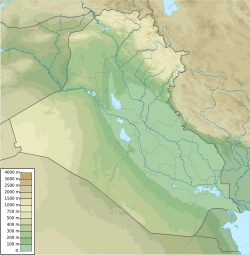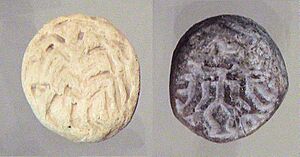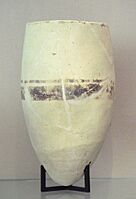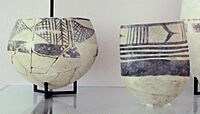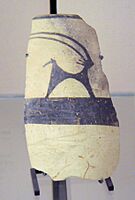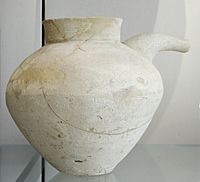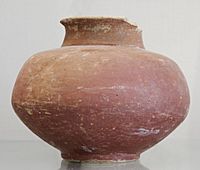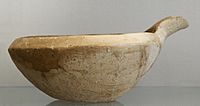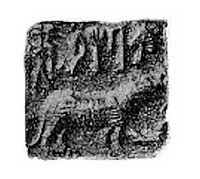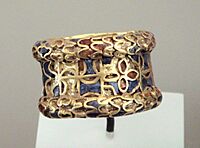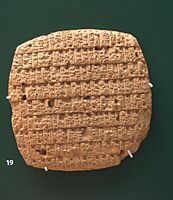Girsu facts for kids
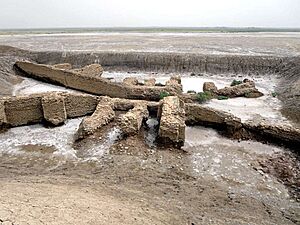
Archaeological remains of constructions at Tello/Girsu
|
|
| Alternative name | Tell Telloh |
|---|---|
| Location | Dhi Qar Province, Iraq |
| Region | Sumer |
| Coordinates | 31°33′43.3″N 46°10′39.3″E / 31.562028°N 46.177583°E |
| Type | Settlement |
| History | |
| Periods | Early Dynastic, Ur III |
| Site notes | |
| Excavation dates | 1929–1933, 2017 |
| Archaeologists | Henri de Genouillac, André Parrot |
Girsu (pronounced "Geer-soo") was an ancient city in Sumer, a very old civilization in Mesopotamia. It was located about 25 kilometers (15 miles) northwest of another important city called Lagash. Today, you can find its remains at a place called Tell Telloh in Dhi Qar Governorate, Iraq. Girsu was a significant place for thousands of years, known for its history, religion, and important discoveries.
Contents
History of Girsu
People might have lived in Girsu as early as the Ubaid period (around 5300-4800 BC). But the city really became active during the Early Dynastic period (2900-2335 BC).
Later, during the time of King Gudea and the Second Dynasty of Lagash, Girsu became the capital city of the Lagash kingdom. It also stayed an important religious center, even after the main political power moved to the city of Lagash itself.
During the Ur III period, Girsu was a major hub for managing the large empire. After the fall of the city of Ur, Girsu became less important. However, people continued to live there until about 200 BC. An old inscription, written in both Greek and Aramaic, was found there, showing its long history.
Archaeological Discoveries
The site of Girsu has two main hills, one about 50 feet high and the other 56 feet high. Many smaller mounds are also scattered around the area. Telloh was the first Sumerian site to be dug up extensively.
Early Excavations
Ernest de Sarzec, a French official, led the first digs between 1877 and 1900. His successor, Gaston Cros, continued the work from 1903 to 1909. During these early digs, archaeologists found an alabaster statue of a woman. They also found a piece of a stone lion dish with ancient Sumerian writing. In 1879, Hormuzd Rassam also visited the site.
Later, Henri de Genouillac led excavations from 1929 to 1931. André Parrot continued from 1931 to 1933. It was at Girsu that parts of the famous Stele of the Vultures were discovered. This stele is an ancient stone monument with carvings. Sadly, the site has also suffered from illegal digging over the years. About 50,000 cuneiform tablets have been found here. These are clay tablets with wedge-shaped writing, giving us clues about ancient life.
Recent Discoveries
Archaeological digs at Telloh started again in 2016. This was part of a program by the British Museum to train Iraqi archaeologists. Since then, they have found a special foundation tablet and many inscribed building cones. These cones often tell us who built a temple or building.
In 2019, work focused on the Mound of the Palace. This is where the E-ninnu, a temple dedicated to the god Ningirsu, had been found earlier. In March 2020, archaeologists announced an exciting discovery. They found a 5,000-year-old area used for religious ceremonies. It was filled with over 300 broken ceremonial cups, bowls, and jars. They also found signs of animal sacrifices and ritual processions for the god Ningirsu. One special find was a bronze figurine shaped like a duck, with eyes made from bark. This was likely dedicated to the goddess Nanshe. An Indus Valley weight was also found, showing ancient trade connections.
In February 2023, experts from the British Museum and the Getty Museum revealed more amazing finds. They uncovered the remains of a 4,500-year-old Sumerian Lord Palace of the Kings. They also found more than 200 cuneiform tablets. These tablets contain important administrative records from Girsu. The E-ninnu temple (also called the Temple of the White Thunderbird), which was the main holy place for the Sumerian warrior god Ningirsu, was also identified during these recent digs.
In 2023, experts from the British Museum also suggested something very interesting. They think that a Greek temple found at Girsu might have been built by Alexander the Great. Researchers believe recent discoveries hint that "this site honors Zeus and two divine sons. The sons are Heracles and Alexander."
Gallery
Ubaid IV artifacts (4700–4200 BC) in Girsu
Uruk Period artifacts (4000–3100 BC)
-
This Uruk period vase is made of terracotta, from around 3500–2900 BC. It was found at Telloh (ancient Girsu) and is now in the Louvre Museum.
-
This vase is made of terracotta with a red slip, from around 3500–2900 BC. It was found at Telloh (ancient Girsu) and is now in the Louvre Museum.
Early Dynastic artifacts in Girsu (3rd millennium BC)
-
This clay tablet shows an account of barley rations given out each month to adults and children. It was written in Cuneiform during the 4th year of King Urukagina (around 2350 BC). It was found in Girsu, Iraq, and is now in the British Museum, London.
-
This doorway was built by Gudea around 2100 BC at Telloh.
See also
- Gudea cylinders
- Ningirsu
- Statues of Gudea
- Cities of the ancient Near East


